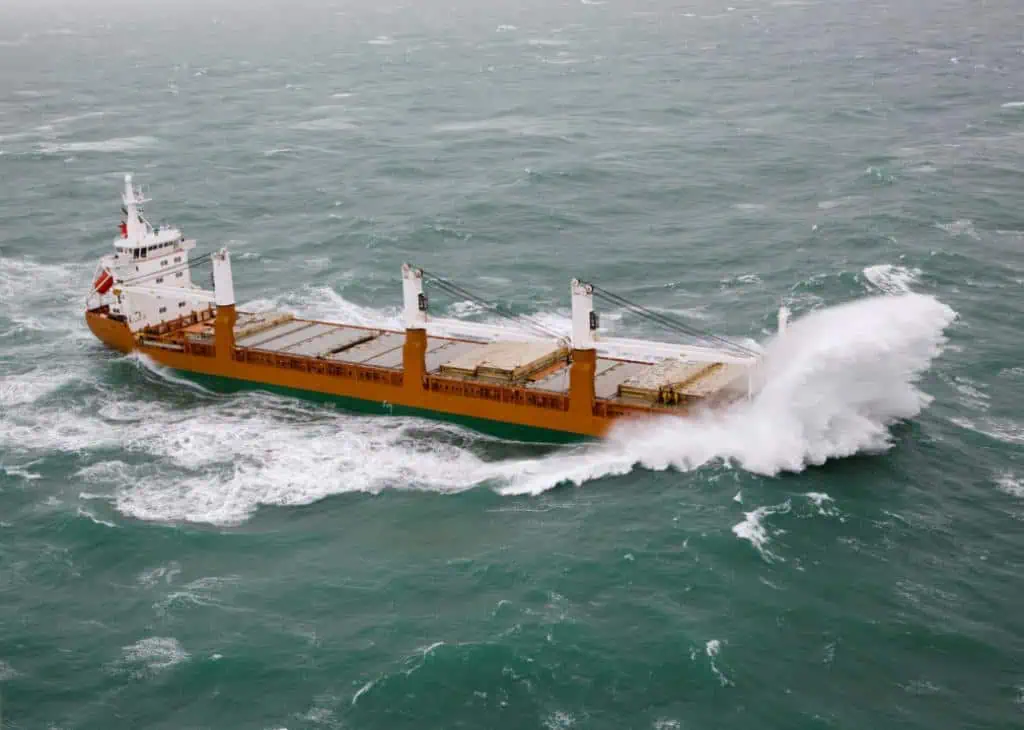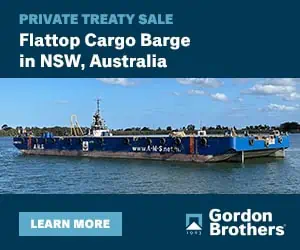Average fuel saving predictions are presented for the route Rotterdam – Québec. The officially available hull geometry called KCS has been used, and the vessel is equipped with Wavefoil’s largest foil module, WF5910. The vessel has a total length of 136.6 meter and represents a vast amount of medium size general cargo vessels, smaller container vessels, chemical tankers etc.
An average fuel saving of 1 512 MWh corresponding to 16% reduction is found for a target speed of 10 knots. For a target speed of 14 knots, the average saving is predicted to be 2 271 MWh, corresponding to 10% reduction.
In addition, the foils contribute to a significant peak shaving effect. Energy consumption statistics shows that energy storage capacity can be reduced by up to 17% dependent on acceptance for delays. Similarly, the installed power can be reduced if retractable bow foils are installed. The reduced need for capacity and installed power might to some degree compensate for the investment in a foil module from Wavefoil, especially for zero-emission energy storage systems.
Benefits of bow foils
The principle of bow foils have been known since the 19th century and can be summarized as below:
FUEL SAVINGS IN WAVES
› Reduced heave (up/down) and pitch (bow up/down) motions
- Less added resistance in waves
- Increased propulsion efficiency
› Wave energy utilization
- Additional thrust due to the propulsion effect of an oscillating foil at forward speed – like a swimming whale
COMFORT AND SAFETY IMPROVEMENTS IN WAVES
› Reduced heave (up/down) and pitch (bow up/down) motions
- Less seasickness
- Increased operability and productivity
- Less shocks and vibrations from bow slamming and diving
- Less water on deck
Retractable bow foils
Wavefoil’s patented retraction mechanism enables optimal performance dependent on the wave conditions. There is neglectable added resistance in calm water with the foils retracted.


Simulation tool
Wavefoil’s internal software “SantaMaria” is used for the simulations. The simulation is verified by third party model tests and CFD (DNV and Cloud Towing Tank). One of the verification studies was performed by two independent CFD doctoral engineers at DNV, both predicting 28% fuel saving in line with Wavefoil’s prediction for a given test case. Contact Wavefoil for more information.
A simulation autopilot tries to maintain an input target speed. The vessel can increase MCR (engine power) up to the installed power. If the vessel still looses speed, this is compensated by a speed increase above the target speed when possible. By this setup, both the vessel with and without foils carry exactly the same amount of goods per year. Thus, the fuel consumptions can be compared in a fair way.
The foils are assumed to be retracted for all weather conditions with negative fuel savings. Wavefoil’s patented retraction mechanism is needed to obtain a significant net saving. Otherwise, the gained saving in waves would be counteracted by added resistance in calm water and following sea.
Setup
The officially available hull geometry called KRISO Container Ship (KCS), designed by Korea Research Institute of Ships and Ocean Engineering, is applied. The geometry is scaled in x-, y- and z-direction to represent a vessel suited for bow foils, see main dimensions below:
Hull length……………………..136.6 m
Length waterline……………..128 m
Hull beam……………………….18.9 m
Design draft…………………….8.5 m
Block coefficient……………..0.62
Displacement…………………..12818 m^3
Wetted surface…………………3406 m^2
Installed engine power………5 500 kW
Propeller efficiency…………..0.66
Transmisison efficiency…….0.97
Foil module……………………..WF5910
Distance from APP to foil….125.5 m
Distance from BL to foil……1.0 m
A voyage factor of 81% (percentage of time at sea) is assumed.
Historical ocean wave data from 2018 to 2020 available from E.U. Copernicus Marine Service Information was used for route simulations. Local variations in wave conditions along the route are accounted for.
Results and discussion
Energy consumption overview in 14 knots
Wavefoil contributes to a reduced demand for engine power in all sea states with a significant wave height larger than 0.75 meters. For smaller waves, the foils are assumed to be retracted.
The figure below gives an overview of the engine load is used along the route. Zero nautical miles is Rotterdam, 3000 nautical miles is Québec and 6000 nautical miles is Rotterdam. The results are presented as a percentage of MCR (maximum continuous rating, in practice the same as installed power).

The engine load is typically higher from Rotterdam to Quebec as expected from wave statistics. The waves in this area tend to go from east to west, meaning that the vessel meets head sea in westbound direction. The difference between the mean curves is approx. 25% in the area 1 000 – 2 000 nautical miles west of Rotterdam.
Similar trends are found for 10 and 14 knots, but the involuntary speed loss is more prominent for higher target speed for the given installed power.
It is worth mentioning that the EEDI index (used to quantify the energy efficiency of a vessel) takes the installed power as input, and the figure above indicates that the installed power can be significantly reduced by installation of Wavefoil.
Average savings in 10 knots
The annual energy consumption without foils is predicted to 9 385 MWh. The average fuel saving with foils is predicted to 1 512 MWh corresponding to 16.1% of the energy consumed for propulsion.
Average savings in 12 knots
The annual energy consumption without foils is predicted to 15 026 MWh. The average fuel saving with foils is predicted to 1 935 MWh corresponding to 12.9% of the energy consumed for propulsion.
Average savings in 14 knots
The annual energy consumption without foils is predicted to 23 104 MWh. The average fuel saving with foils is predicted to 2 271 MWh corresponding to 9.8% of the energy consumed for propulsion.
Peak shaving in 12 knots
It is relevant to study the effect of peak shaving separately since it has a major impact on the ability to maintain the target speed. Peak shaving is also relevant for future energy storage solutions where energy storage capacity might be critical.
The figure below illustrates the probability for exceedance for the energy consumption per trip in 12 knots. The lowest possible fuel consumption per trip is approx. 800 MWh. An energy increase of 50% is exceeded 10% of the trips with foils, while it occurs almost 40% of the trips without foils.
If a probability of exceedance of 10% can be accepted, the vessel needs to carry 1 200 MWh with foils against 1 450 MWh without foils corresponding to 17% reduction.

Written by Kristian Wingan Wold and Audun Yrke
Contact person: Pål-Ove Husøy













